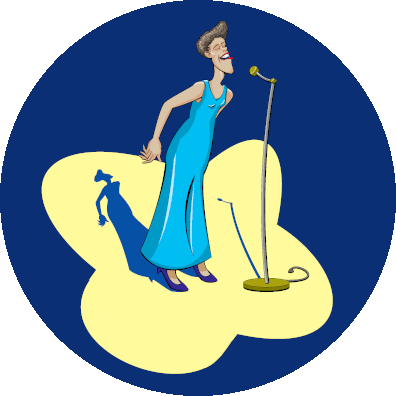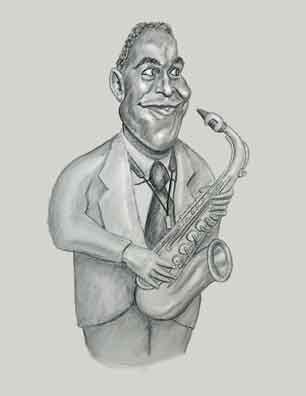Sarah Vaughan

(Click on the image to zoom in and out.)
| Sarah Vaughan was probably my favorite vocalist out of all of them. | |
| - | Smokey Robinson |
Like many African American singers born in the earlier years of the 20th century, Sarah Vaughan began singing at church. And in an era where good music had to be live music, every house had a piano in the parlor. Sarah learned to play the instrument and acquired considerable felicity.
The whole family was musical, but they were also religious and so they expected Sarah to play only proper music. But growing up in the 1920's and 30's in surburban New Jersey, they were also near the centers of the Harlem Rensaissance. While still in her early teens Sarah would sneak out at night to listen to the bands when they were performing at hotel ballrooms and in the nightclubs. Her folks were not pleased when they found out about their daughter's nightime forays.
New York was a good place for a singer of talent as there were lots of "amateur hours" sponored by theaters and clubs for the aspiring performer. Sarah decided she was going to be a singer, and she dropped out of school after her junior year and spent her time entering the contests. Sometimes the prize was the privlege of singing with the house band for a while. Sometimes it was cash. Sometimes it was both.
In 1942 - Sarah was 18 - she entered a contest at the famed Apollo Theater. She won the $10 prize and had the privilege of singing there for a week. It was then she caught the ear of bandleader Earl Hines and his singer Billy Eckstine. Now old enough to be out on her own, Sarah joined Earl's band both as a singer and pianist.
Sarah was well-liked and enjoyed hanging out with the guys after the shows to have a few drinks and smokes. The fellows treated her nicely although by modern standards the joshing and teasing could be rather rough. Word's like !, !, and !! were thrown out with great élan. But Sarah could toss it back and soon picked up the nickname "Sassy".
When she started singing with Earl, Sarah didn't have a lot of fancy clothes which was a bit of a problem as Earl required his band members to be immaculately dressed. The fellas traveled with a trunk full of fresh suits so they wouldn't looked ratty. But Sarah showed up for her first trip with her extra clothes in a paper bag. Knowing this would never do, Earl bought her a special evening dress for performing and the guys pitched in to get a proper suitcase.
Sarah's performances generally recieved good reviews from both the black and white press (famed jazz critic Leonard Feather said he immediately recognized her talent). She worked to improve her singing by studyng with Billy but she listened to the playing of fellow bandsmembers Dizzy Gillespie and Charlie Parker. Diz said she liked Bird's playing best.
Sarah's Friends

Diz ...

... and Bird
She liked his playing best.
Although a skilled pianist and a bonafide member of the musician's union, Sarah's real forte was singing. When Billy formed his own band in 1943, he joined forces with Diz and asked Sarah to be the female vocalist. It was with Billy that Sarah cut her first record "I'll Wait and Pray". She stayed with Billy for two years and after World War II, she began her solo career.
Her manager (and first husband) was George Treadwell, a trumpet player who had moved into the business side. Now a star in her own right, Sarah would still appear with the bands of Earl, Billy, and Diz, and later with Count Basie, Miles Davis, Percy Faith, and Quincy Jones (she even appeared with Hugo Winterhalter). Later she organized her own groups: Sarah Vaughan And Her Octet, Sarah Vaughan And Her Orchestra, Sarah Vaughan And Her Trio, and Sarah Vaughan And The All Star Band.
By the 1950's no longer did you have to go out to theaters or clubs to hear good music. Instead everyone was listening to songs in the comfort of their own homes. And you didn't have to listen to songs on tinny, scratchy "record players" where you had to get up every three minutes to change the tune. By mid-decade "high-fidelity stereo systems" were available that could automatically play a queue of long-playing albums for literally hours of listening pleasure. Although taking up as much room as a living room sofa and costing as much as an automobile, stereos began taking their hold of American culture.
Over the course of her career Sarah was featured on over a thousand recordings released as singles, albums, and compilations. Of course she toured extensively and from 1947 to 1989, her travels took her to Canada, Italy, Scotland, England, Japan, South Africa, and Brazil.
Sarah is considered one of the greatest jazz singers of the 20th century, but given the variety of her tunes, she said that she was surprised to be considered as such. Being born in 1924, Sarah's career necessarily spanned The Big Generational Shift in American music. When she first began singing, swing - a jazz genre - was still the major style of popular music and kids and their parents enjoyed the same music.
But after World War II, the expense of moving twenty or so guys with their wives from town to town had the band leaders scrambling to reduce costs. Naturally the simplest way to cut cost was to cut personnel and although the big bands didn't completely disappear, they were being squeezed out by smaller combos. But perhaps the biggest change was that with the rise of the jazz style called bebop, jazz quit being a dance music and was quickly loosing fans. Kids who wanted to cut the rug were turning to that new fangled sound called rock and roll.
Sarah had no problem with the Big Shift and she also sang what are called popular tunes written by composers as varied as Irving Berlin, George Gershwin, Hoagie Carmicheal, Henry Mancini, Herb Alpert,and John Lennon. She even sang songs written by the winner of the 2016 Nobel Prize in Literature, Robert Allen Zimmerman.
Her television appearances were many and on shows hosted by Johnathan Winters, Jackie Gleason, Arthur Murray, Perry Como, Jack Paar, Regis Philbin, Sammy Davis, Skitch Henderson, Joey Bishop, Glenn Campbell (!), Dick Cavett, Merv Griffin, Mike Douglas, Johnny Carson, and Ed Sullivan. Sarah's life was also included in the American Masters series by PBS.
Of course, Sarah was awarded many official honors. She won an Emmy in 1981 for Rhapsody and Song: A Tribute to George Gershwin, and two Grammys in 1983 and 1989.
Like many of her generation, Sarah was a heavy smoker and this began to effect her health. But she kept performing almost to the end. Her last performances were in New York in 1989 and she died the next year age 66.
References and Further Reading
Sassy: The Life Of Sarah Vaughan, Leslie Gourse, Da Capo Press, 1994.
Queen of Bebop: The Musical Lives of Sarah Vaughan, Elaine Hayes, Ecco, 2017.
"Sarah Vaughan", NNDB.
"Record Notes", The Chicago Star., September 6, 1947, p. 13.
"What Bob Dylan Learned From Soul", Lawrence Joseph, Literary Hub, October 15, 2016.
"Sarah Vaughan", Internet Movie Data Base.
"Sarah Vaughan", Discogs.
"Sarah Vaughan", Concert Archives.
"Sarah Vaughan", Set List.